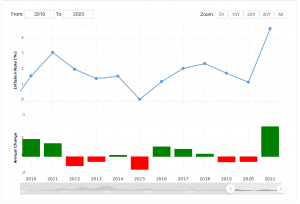
The United States House of Representatives on Friday passed the Inflation Reduction Act, a legislation that envisages the largest climate investment by the US. The Senate had passed the Bill on Sunday. The Act that will impose new taxes to fund climate investment and healthcare subsidies for millions of Americans will now be sent to President Joe Biden’s desk for his signature. The IRA 2022 proposes a 15% minimum tax on businesses that make $1 billion plus profits.
The IRA is far less ambitious than President Joe Biden’s initial plans envisaged in the Build Back Better Act, but still is historic for two reasons — huge investment to address climate change and provisions that allow Medicare to negotiate the prices of prescription drugs.
US inflation trend

The clean energy investments envisaged in the Inflation Reduction Act will address the runaway inflation in the US that is hovering around 9%, levels unseen in the last 40 years. It is estimated that energy prices are responsible for a third of the annual consumer price inflation. It seeks to insulate US prices from unreliable global fossil fuel supplies, thereby reducing domestic prices.
READ I Brewing trouble: Climate change can aggravate threat of pathogenic diseases
Inflation Reduction Act is more about climate change
Limiting climate change is the largest priority of the legislation with proposals worth more than $360 billion investment in energy and climate change plans over the next 10 years. The provisions include cash incentives on electric vehicles and tax breaks to propel clean energy transition. The backers of the Act claim that the provisions will cut carbon emissions by 40% by 2030, nearly 10% less than President Biden’s original plan.
The IRA seeks to encourage consumers and industry to move away from fossil fuels. The largest share of funding will go to tax breaks on electric vehicles, solar panels, wind turbines, and energy efficiency. It will also encourage local manufacturing and energy efficiency at industrial sites to help cut carbon emissions. The legislation will also allocate more funds for restoration of forest and coastal areas.
The Act proposes to slap a methane fee to punish fossil fuel firms for emissions of the dangerous greenhouse gas. There will be substantial provisions to improve climate resilience of vulnerable communities by reducing pollution. Also, huge provisions are envisaged to help areas that are badly affected by climate change.
READ I Covid-19 loosens its grip, but is the worst over?
IRA 2022 and healthcare reforms
The Inflation Reduction Act will have a major bearing on the healthcare costs for Americans as it allows Medicare to directly negotiate the price of some prescription medicines with the industry. This will ensure that the annual out-of-pocket expenditure by Americans on prescription drugs will be less than $2,000.
The Act contains some major steps that include an expansion to the Affordable Care Act. Currently, the health insurance cost for American households is limited to 8.5% of their earnings. This provision introduced in 2021 helped the vulnerable American households survive the pandemic crisis, but it is expected to lapse by 2022-end. The legislation will extend these subsidies for another three years, till the end of 2025, at a cost of $64 billion.
Funding climate, healthcare expenses
The Inflation Reduction Act will fund the additional expenditure by way of its provisions through a new 15% minimum tax on corporates that post profits higher than $1 billion. The corporate tax rate in the US is 21%, but several large companies such as ExxonMobil and Amazon pay much less. The new tax was expected to raise $313 billion, but will collect only $222 billion after a compromise deal to win Senator Kyrsten Sinema’s vote.
Companies that buy back their shares will be levied a 1%. Currently share buybacks by corporates are not taxed. This will earn the exchequer $74 billion in revenues. The Act also will fortify tax evasion enforcement to earn higher revenues. This will shore up revenues by $124 billion. The single largest revenue windfall will come from prescription drug pricing reform. This will result in additional revenues of $265 billion to the exchequer.
President Biden’s $1.75 trillion Build Back Better legislation was introduced last year. It was passed by the House in November, but could not cross the Senate hurdle after Democrats failed to secure all their votes. This IRA contained several proposals such as government-paid family and medical leave, funding for universal pre-school for nearly 6 million children, and child care subsidies.
Will IRA 2022 bring down inflation?
The Inflation Reduction Act will address inflation through a three-pronged approach — reduction in federal deficit, impetus to green technology and products, and curbing price rise in some prescription drugs. But these may not have an immediate impact on inflation as they do not address food and energy costs directly.
The possible benefits of the IRA are hotly debated. A one-pager on the legislation by Senate Democrats says it will cut the deficit by more than $300 billion till 2030. Senator Bernard Sanders quoted Congressional Budget Office to say that the IRA will have a negligible effect on inflation.
Several economists agree that the legislation will not have a significant short-term impact on inflation. But the thrust on renewable energy is expected to protect consumers from increases in global energy prices. But nobody is willing to underestimate the significance of the Act. Many economists and commentators see it as a climate change Act. While more needs to be done on climate front, this can be a forerunner of several such legislations.
Is there anything in the Inflation Reduction Act for India to emulate? India already has a 15% minimum alternative tax in place, but some of the largest corporates are paying much less. Successive governments in India have failed to make the corporates pay a fair share of their profits as tax. So, India’s greening has to happen from its powerful businesses.
Two of India’s most powerful corporate groups, Reliance Industries and Adani Group, have launched ambitious clean energy projects. India’s green mobility sector is spearheaded by the Tata Group. India’s steel and cement industries, two worst polluting sectors, also have started their quest for sustainability.
So, India can be expected to meet the revised environmental targets without much trouble. But as the manifestations of climate change has started impacting the global population, India may have to come up with stronger mitigation action. For the country, the Inflation Reduction Act can provide a template for future action.
Anil Nair is Founder and Editor, Policy Circle.

